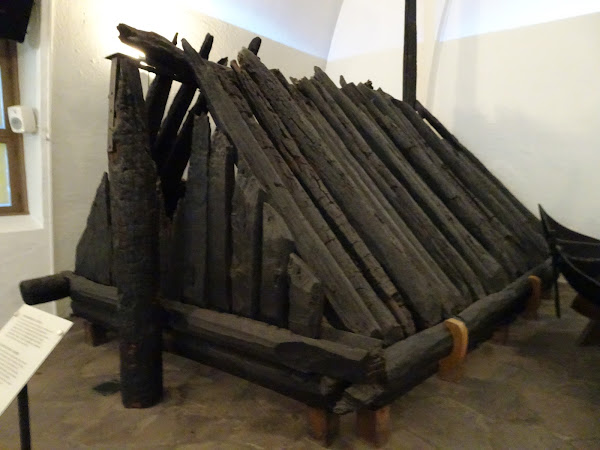
The Vikings burst out of Scandinavia in the late 8th century and for the next three hundred odd years rampaged across Europe, the Mediterranean, the Russian steppe and even North America. One of the driving forces behind this expansion was the advance of naval technology in the form of the Viking longship. These sleek, clinker-built, open ships were capable of undertaking long, open-sea voyages. They were fast, relatively easy to handle and crew, and their shallow draft allowed them to travel far up rivers, allowing them to raid towns and villages that thought they were far enough from the sea to be safe from marauding Viking bands.
The Vikings weren't only pirates and raiders, they were also traders. From Scandinavia, they set off through the great Russian river systems, eventually reaching the Black Sea and Constantinople. They traveled as far as the Caspian, making contact with the lands of the Islamic Caliphate. Settlers followed the traders and the Rus "the boat men" settled in the land of Russia, giving that country its modern name.
The Vikings also undertook some extraordinary voyages of exploration. Setting out from Norway, the Vikings discovered and settled the Shetland and Faeroe Islands north of Scotland. How they navigated to these tiny, windswept islands in the middle of the North Sea is anyone's guess. From there they spread north to Iceland, which still uses the middle Viking alphabet, pronunciation and naming conventions of the 12th century. From Iceland they settled in Greenland and then on to North America, setting up small villages in Baffin Island and Newfoundland in what is now Canada. None of these settlements would survive and only scant archaeological traces remain.
In Europe, the Vikings would settle in England, Scotland, Ireland and northern France. The northern French would become the Normans, conquering England in 1066AD. The Normans would conquer Italy and the Kingdom of Sicily. They invaded the Byzantine Empire in the 12th century and would lead the Crusades. The Crusader kingdoms and counties owed their existence to the Norman's warlike spirit.
Longships were a central feature of the Viking world and it was no surprise that when a chieftain or king died, he chose to be buried in this symbol of power and prestige. Sometimes an older ship was used for this purpose, while on other occasions a specially build vessel was used. The ship was placed into an excavation, the deceased and his grave goods were loaded aboard and then the ship was covered with a burial mound. Standing out in the landscape, these burial mounds often attracted the attention of grave robbers, who damaged and destroyed a great many.

In 1879, some village children in the town of Gokstadt, decided to dig into the side of a great burial mound that stood in a local field. The tomb had been robbed centuries before so little of value was expected to be found, but when the children discovered the remains of a wooden boat, local historians and archeologists took an interest. In 1880 the tomb was professionally excavated and the remains of a 23.8 metre longship. The ship was exceptionally well preserved having been buried in a layer of blue clay.
The occupant of the ship grave was a 40 year old male whose bones showed signs of violence. His femur had been severed by a sword blow and a knife or sword had been run through his side. He had been placed within a small cabin erected on the deck of the ship. He was surrounded with grave goods, including swords, shields, a small cart, a sled, along with 12 horses and 6 dogs. The ship itself was a well made and very large warship, indicating the occupant was a very powerful individual.

25 years later, an excavation of a Viking burial mound at Oseburg Farm, near Tonesberg, uncovered another spectacular ship burial. This ship was marginally smaller than the Gokstadt ship at 21.3 metres, but had a much broader beam and a highly ornate prow and stem. While the Gokstadt ship was undoubtedly a warship, it seems likely the Oseburg ship was more ceremonial in function. This ship contained two bodies, an 80 year old woman and a 50 year old woman, along with a substantial amount of grave goods. It is uncertain which of the women was the focus of the burial.

The Viking Ship Museum in Oslo, Norway, was opened in 1926 to hold the preserved remains of the Osberg and Gokstadt ships along with their artifacts. The museum is built in the shape of a Scandinavian cruciform church.

Upon entry, the visitor is presented with the magnificent Oseberg ship.

Oseberg

The Gokstadt ship is actually half a metre longer than the Oseberg ship, but the lower prow and sleeker lines make her look smaller.

From the viewing landing you can get a decent view into the ship

Part of an intricately carved prow

A carved dragon head

The ornamental sled from the Gokstadt ship

Another carved dragon head

And another

Viking boots

The wheeled cart from Gokstadt

In the third hall is the remains of the Tune ship and a number of small boats. The Tune ship is much poorer condition that the others.

This cabin housed the body of the chieftain in the Gokstadt ship.

Along with a couple of small boats.

This style of boat is still to be seen in Scandinavian waters.

A couple of contemporary boats across from the Kon Tiki Museum a little way up the road.
As at 2022, the Viking Ship Museum is closed for reconstruction. It is planned to reopen in 2025-26. https://www.khm.uio.no/english/visit-us/viking-ship-museum/

If the rebuild looks anything like the artwork, the new museum will be magnificent.





































